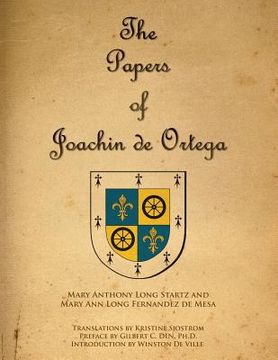Reseña del libro "The Papers of Joaquin de Ortega (en Inglés)"
Joaquin de Ortega y Prieto was born August 2, 1755 in Tordesillas (Valladolid), Spain. He died in 1826 in Opelousas, St. Landry Parish, Louisiana. After a career in service to his country he settled in Opelousas with his family and raised cattle. Ortega entered military life and became 'Comisione Artillery' or 'Guardian Royal Military' in Fort Pensacola living inside the compound on the 1784 census with his wife and oldest child. His revolutionary service was Guardian of the Royal Artillery at Ft. Pensacola. Through letters between Ortega and various Spanish officials, we know Ortega was involved in traveling to present day Texas to arrange for cattle to be purchased and delivered in Natchitoches to feed the troops of Bernardo de Gálvez.Winston Deville, the internationally recognized authority on colonial Mississippi Valley/ provincial Louisiana genealogy and history, has written a number of articles on Ortega over the previous 30 years. Winston is also a direct descendent of Ortega. As mentioned, Ortega settled in the Opelousas area and is the progenitor of many citizens in the region. This book is a time line of documents that have survived and whose contents gives us a glimpse of the personal and business life in the Spanish colonies during the period.Ortega married Marie Soto de St. Denis originally from Natchitoches. Marie was the granddaughter of Louis Juchereau-De-Saint- Denis and Marie Manuela Sanchez Navarro y Gomez Mascorro. Her grandparents - one famous French explorer and one Spanish - the granddaughter of Major Diego Ramon Governor of Coahuila and later Commander of the Royal Presidio San Juan Bautista de Rio Grande, Coahuila, Mexico, were married 17 February 1715/1716 in San Juan Bautista de Rio Norte, Coahuila, Mexico. Marie Soto de St. Denis' grandfather, Louis also founded the post of Natchitoches. Today there are many people in Coahuila that may have Louisiana cousins and are not aware of this connection. In the late eighteenth and early nineteenth centuries, immigrants were arriving in Louisiana (Acadians, Canary Islanders, Saint- Dominicans, and Americans), and many of them settled in the countryside where they became farmers. Under the Spaniards they received free lands of only a few arpents of river or bayou front and about forty arpents deep. This system allowed more people to have water-access to send their crops to market. There were always the fortunate few who either received more commodious land grants or were able to purchase them. Larger farmers, also known as planters in Louisiana and the South, grew commercial (money-making) crops such as cotton, sugarcane, tobacco, and other items. They possessed the labor, often slaves or money or both to hire free workers to raise labor-intensive crops. Smaller farmers, on the other hand, possessing neither the resources nor the labor, dedicated themselves to growing smaller acreages of some of these commodities and foodstuffs. Joaquín de Ortega did not number among the least fortunate. With an education, probably in possession of some money, help from affluent in-laws, he achieved a degree of economic well-being in his farming efforts. He probably could be described as middle class at a time when few people could claim this status. Possibly some planters belonging to the upper class also lived in the area where they owned land. Usually, however, they were not full time residents and visited randomly. These economic elites usually enjoyed political and social lives that differed vastly from the common folk. The bulk of the white inhabitants were ordinary people who possessed almost no wealth. They typified what life was like for most of the people of the earliest national era. Nevertheless, they managed to survive as they had in the past and possibly they could carve out a niche for themselves that mitigated the hardships of the life they inherited.

